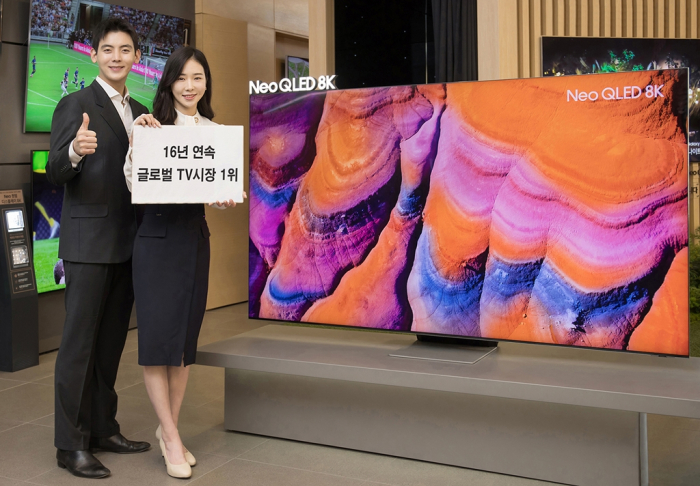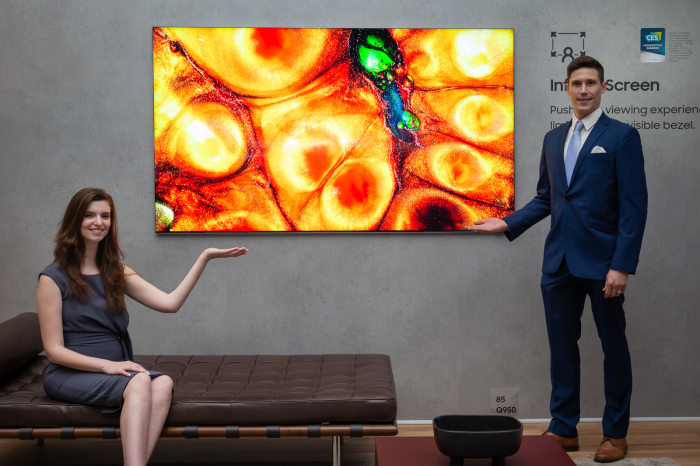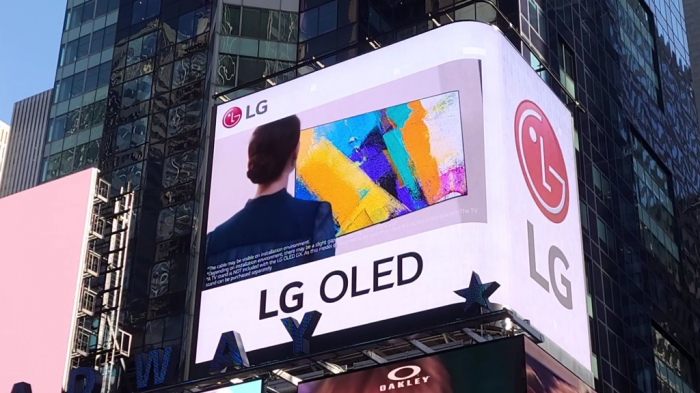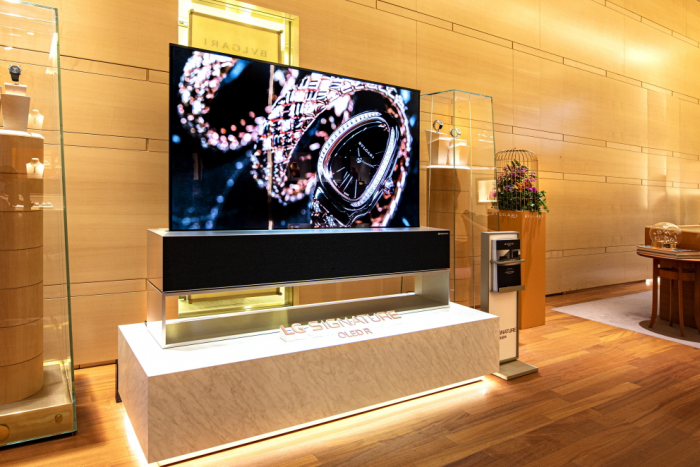Home appliances
Samsung, LG dominate global TV market with premium models
Industry research firms say demand for OLED TVs will continue to rise this year, boding well for Samsung and LG
By Feb 20, 2022 (Gmt+09:00)
2
Min read
Most Read
LG Chem to sell water filter business to Glenwood PE for $692 million


KT&G eyes overseas M&A after rejecting activist fund's offer


Kyobo Life poised to buy Japan’s SBI Group-owned savings bank


StockX in merger talks with Naver’s online reseller Kream


Meritz backs half of ex-manager’s $210 mn hedge fund



South Korea’s two home appliances giants – Samsung Electronics Co. and LG Electronics Inc. – dominated the global TV markets last year with strong sales of their premium and large-screen models targeting high-end consumers.
According to London-based market tracker Omdia on Sunday, Samsung was the world’s leading TV vendor for the 16th straight year in 2021 with a market share of 29.5% in terms of sales value. LG came in second with its record 18.5% share. Combined, the two companies controlled nearly half the global TV market last year.
Omdia data showed Samsung was the dominant player particularly in the premium segment, accounting for 42.1% of the market for TVs priced at $2,500 or higher a unit. In the 80-inch and larger-size TV segment, Samsung controlled 44.9% of the market.
Samsung said its market leadership was helped by robust sales of its quantum light-emitting diode (QLED) TVs.

The company sold 9.43 million QLED TVs last year, accounting for 44.5% of its total sales of premium models selling at $2,500 or higher prices. Since the launch of the model in 2017, Samsung had sold a total of 26 million QLED TVs over the past five years.
Samsung ascended to the industry’s top post in 2006 with the launch of its Bordeaux LCD TV.
The company has since unveiled a series of market-leading models, including an LED TV in 2009, a smart TV in 2011 and its first QLED model in 2017.
Last year, it launched several flashy flagship TV models, including new Mini LED TVs, one dubbed the Neo QLED, and MicroLED TVs in various sizes.
According to Samsung, the Mini LED offers a more effective, more efficient way of backlighting the LCD pixels of a TV screen. QLED TVs use tiny LED chips that generally range in size from 100 to 200 micrometers for backlighting, providing better resolution and higher clarity.

LG, LEADING OLED TV VENDOR
Meanwhile, LG Electronics, the world’s second-largest vendor in the overall TV market, said the shipment of its OLED TVs almost doubled to 4.05 million units last year.
The global OLED TV market grew 80% on-year to 6.53 million units in 2021.
Omdia expects the global OLED TV market to continue to grow to 8 million units this year, with the segment’s share of the entire TV market estimated at 12.7%.
LG has said it expects its OLED TV models to account for 42.1% of the $1,500 and higher-priced TV market this year.
Last week, the company debuted the world’s first 42-inch OLED TV, which it said is ideal for game consoles such as PlayStation 5 and Xbox Series X.

John Lewis, a high-end department store in the UK, said on its website it is taking pre-orders for the industry’s first OLED TV to feature a 42-inch display, the world’s smallest, at £1,399 ($1,906).
Previously, OLED TVs were available with screen sizes of 48-inches and upwards.
LG is the world’s largest manufacturer of OLED TVs with a market share of over 60%, although crosstown rival Samsung is the dominant player in the overall TV market.
Demand for OLED TVs that offer stunning picture quality has been growing rapidly as consumers, including gamers, are attracted to large-size LED TVs as big-screen gaming gains popularity in the pandemic era.
Write to Su-Bin Lee at lsb@hankyung.com
In-Soo Nam edited this article.
More to Read
-
 Home appliancesLG launches world’s first 42-inch OLED TV in UK at £1,399
Home appliancesLG launches world’s first 42-inch OLED TV in UK at £1,399Feb 18, 2022 (Gmt+09:00)
2 Min read -
 Home appliancesSamsung CEO: M&A deals in offing, to expand MicroLED TV facilities
Home appliancesSamsung CEO: M&A deals in offing, to expand MicroLED TV facilitiesJan 06, 2022 (Gmt+09:00)
2 Min read -
 Home appliancesLG welcomes Samsung’s likely re-entry into OLED TV market
Home appliancesLG welcomes Samsung’s likely re-entry into OLED TV marketJan 05, 2022 (Gmt+09:00)
2 Min read -
 Home appliancesLG Electronics leads industry shift toward OLED TVs
Home appliancesLG Electronics leads industry shift toward OLED TVsSep 01, 2021 (Gmt+09:00)
2 Min read -
 Home appliancesLG Electronics scores big in first-half US OLED TV market share
Home appliancesLG Electronics scores big in first-half US OLED TV market shareAug 30, 2021 (Gmt+09:00)
2 Min read -
 Premium TVsLG launches QNED TV to rival Samsung in premium TV market
Premium TVsLG launches QNED TV to rival Samsung in premium TV marketJun 30, 2021 (Gmt+09:00)
2 Min read
Comment 0
LOG IN


